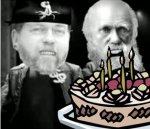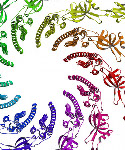

Welcome to the 104th edition of the Tangled Bank blog carnival (a biweekly showcase of good biology posts selected by the authors themselves). Rigorous calculations and archaelogical research have revealed that this is the Tangled Bank’s 4th birthday. In the birthday spirit, several people sent appropriately themed presents.
Chris gave some great gifts (with a few caveats); a protien to resist radiation (may cause cancer), an enzyme to live longer, slimmer and stronger (but anti-socially and so far only in mice), and a transcription factor that can reverse skin aging (also in mice).

Even more microbiological gifts came in. steppen wolf wrapped up a nice box of cancer-fighting microRNA while Nimravid added some surprisingly robust bacterial gene networks. Finally, Ed chipped in a giant symbiotic bacteria with 40,000 copies of DNA and some influenza virus (straight from the flu’s tropical Asian source) and I contributed some cancer fighting bacteria.
I’m running out of synonyms for “give” and ways to twist submissions into presents, so let’s leave the birthday party behind and see the rest of the submissions.
First some plant related posts. Ocean Rambles has a bunch of nice pictures of the endangered Garry Oak ecosystem (and spring flowers) on Vancouver Island. Also concerned for plants, rENNISance woman links to the new idea of plant dignity (and a very odd stem cell comment thread).
On cultivated plants, Jeremy warns that relatively little money is being spent on farming research, especially for developing countries that need it most, and urges farmers to stop being pushed around by an agricultural corporation that sounds like the RIAA of farming (plus health effects).
Continuing the topic of corporate machinations, Biotunes describes an article (and personal experience) about bias in medical publications. On the lighter side of medicine, you can play doctor in space with a cool little flash game from the BBC.

Moving on to scheming of the creationist sort, Greg theorizes why physics doesn’t have argumentum ad Nazium documentaries and points out that biology at the molecular scale is difficult to comprehend. Monado gives an example of this difficulty by comparing creationist drawings to a real electron micrograph of a flagellum. Late update: On the topic of pseudoscience, Podblack Cat asks “are women more superstitious?” (and throws in quite a literature review for the topic).
As an antidote to that intelligent design, Alvaro has details on making new neurons and a bunch of interviews of neuroscientists and cognitive psychologists.
Finally, 10,000 Birds (the only returning blog from Tangled Bank #1 [this post if you’re curious]) describes coots (the bird, not the elderly).
I hope you enjoyed this Tangled Bank. The next edition is at the Beagle Project. You can email submissions to the hosts directly here or here or to the standard host@tangledbank.net before May 14th. Here’s to four years of biology blogging carnivals and hopefully many more.
steppen wolf | 01-May-08 at 4:33 pm | Permalink
I like that flagellum. A lot.
Nice edition – short and sweet!